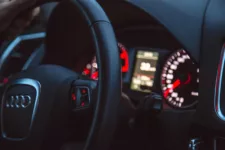The US has seen a 14% rise in road fatalities over the last few years, and many research institutions blame technology-related distractions, including smartphones. At least 3,000 teen deaths and 300,000 injuries annually have been connected with texting while driving, according to Cohen Children’s Medical Center. These trends have facilitated a need to come up with technological innovations to aid drivers who easily get distracted. Systems that assist drivers to maintain their lane are already saving lives and have a lot of potential in the future. As these innovations continue to grow in sophistication, driving is becoming much more comfortable and safer than ever before.
Lane Departure Warning (LDW) and Lane Keeping Assist (LKA)
If vehicles had been equipped with LDW systems in 2015, more than 80,000 crashes would have been prevented, as reported by IIHS. These systems utilize turn signals, road markings, and side rails to make reliable detections and warn the driver when the vehicle starts to cross. LKA helps to keep the vehicle in its path using automatic steering and braking if the car begins to drift astray. This system also works by discouraging lane jumping and careless overtaking, thereby ensuring that both the vehicle and driver are protected on the road. Though there is no current data to show its usefulness, 70% of drivers believe that it could help save many lives in the near future, according to Intersog.
Lane centering assistance system
Most lane-keeping systems only intervene when you start to cross your lane, and this can cause an effect whereby the car seems to bounce back and forth between lane boundaries. However, the most advanced systems, that dictate the future, are able to center the entire car in its lane using steering assist, sophisticated cameras and other features. A perfect lane centering system should assist the driver without opposing their intention, according to Consumer Reports. For now, these systems are found in luxury vehicles such as Volvo’s S90 and Mercedes Benz’s new S-class. However, the future will see such companies install these systems in more affordable vehicles as Autotrader reports.
The future of lane keeping systems
Automobile manufacturers project that lane assistance technology will continue to improve in accuracy as cameras get more and more sophisticated. For instance, BMW is increasingly using multiple camera systems that allow vehicles to use 3-dimension views. For example, the new X5 uses 3 cameras that are expected to deepen its 360-degree coverage. Major car-building companies report that lane-keeping assistance is an essential move towards realizing self-driving vehicles. Soon, cars will have radar added to cameras which will make them reach level 2 autonomy that is a huge step towards reaching the self-drive milestone.
Gone are the years when in-vehicle safety was limited to airbags and seat belts. From monitoring the way cars are driven to avoiding collisions and detecting the level of alertness, vehicles are becoming increasingly safe. Car makers are looking for technology that reduce high crash risk and the lane-keeping systems are doing the part. Manufacturers encourage new car buyers to take time to understand how their car-safety-systems work in order to utilize their maximum potential, as per Consumer Reports. Much later, the industry is set to enjoy critical breakthroughs that will include self-driving vehicles, car stopping airbags and augmented reality dashboards.








